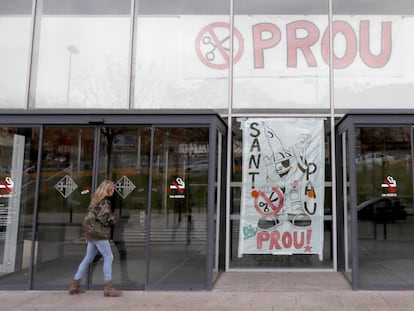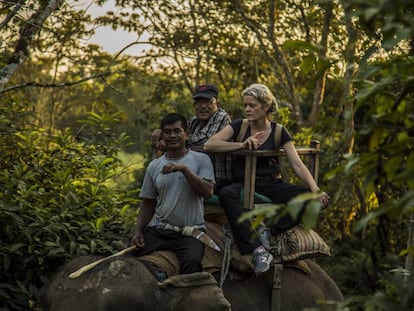The fight to save little Tiago
A three-year-old from Galicia tries a new treatment that could put the brakes on spinal muscular atrophy

Last September, a few days after he turned three, Tiago underwent a spinal tap in the pediatric ICU of Santiago de Compostela University Hospital Complex (CHUS). Doctors extracted 2.5 milliliters of spinal fluid and injected the same amount of Spinraza, a new medicine for spinal muscular atrophy (SMA).
He told me: look mom, now I am very strong Tiago's mother Carmen Vázquez
The drug was not approved for commercial sale in Spain because the laboratory that makes it, the US multinational Biogen, had not reached an agreement with the Health Ministry about its cost, which is around €800,000 per person per year. But thanks to an agreement reached by the Galician regional parliament following pressure from GaliciaAME, which to date is the only association of people affected by SMA in Spain, the Galician health department purchased the drug in Europe and treated the young boy from A Coruña.
Two months later, little Tiago can hold a pencil between his fingers, which until now had been doubled over into a claw, and sit upright on the sofa. “The doctors are surprised by his progress, and while I don’t want to have false hopes, it’s true the degenerative process is slowing down, and very quickly in his case,” says his mother, Carmen Vázquez.
Spinraza, approved by the US Food and Drug Administration in December 2016 and by the European Medicines Agency (EMA) last June, was acquired by the Galician health department as soon as it became available in Germany – the first European country to buy stocks of the treatment. This was made possible after GaliciAME successfully petitioned the Galician parliament to categorize Spinraza as a medicine for compassionate use – a classification that allows for a drug to be administered to patients who are seriously ill before it is officially approved throughout Spain. This sped up the process, meaning the health department could purchase the treatment in Europe until the Spanish health ministry reached an agreement with Biogen.
Around one in every 10,000 people suffer from SMA and up until now there has been no effective treatment
Those affected by SMA worried that distribution of the drug would be slowed down by budget disagreements – just as had happened with the authorization of hepatitis C medication, when two senior Galicia government officials were accused of homicide after delaying administration for “budgetary reasons.” But this was not the case.
“We still can’t believe it,” says Mercedes Álvarez, the president of GaliciAME who founded the organization after being diagnosed with SMA at the unusually late age of 27. It was her determination that pushed the association to present the proposal to the regional parliament. “We thought it was going to be a long battle – that we would need to chain ourselves to the parliament building to get anywhere, but in seven weeks everything was organized,” she says, adding that the move has opened the door “for other Spanish regions” to take similar action.
Mercedes is clear about the urgent need to access the treatment: “We don’t want to lose time because it is important to slow down the degenerative process as soon as possible.” She explains that the drug was offered to all Galicians with the disease in order of age (youngest to oldest) and severity.
We thought we would need to chain ourselves to parliament to get anywhere, but in seven weeks everything was organized Mercedes Álvarez, GaliciAME president
One in every 10,000 people suffer from SMA, a disease which causes the progressive loss of muscular strength, affecting not only a person’s ability to walk, but also to breathe and swallow, and often ending in death by asphyxiation. Children diagnosed with the disease rarely make it past the age of two and until now, there has been no effective treatment.
Tiago and two other young children (one of them only just two months old) have begun the new treatment in different regional hospitals. Soon, dozens more people will have access throughout Galicia. Everyone except Mercedes, the driving force behind the initiative. She was the second person in Spain to be diagnosed with SMA at such a late age: she has an abnormal genetic mutation on a chromosome. “After two and half years, the doctors still can’t find the genetic mutation but I’m convinced that some day they will find it, as well as a drug that doesn’t just repair a specific chromosome,” she says, adding that she is delighted with what her work has achieved for others.
Now GaliciAME is looking to share its experience with other regions to help other children with SMA access the drug as soon as possible. “We are aware that this is not a definitive cure,” says Mercedes, “but it is a huge step forward that gives little ones the possibility of living a longer and better life.”
At just three years of age, Tiago is not aware of what has happened to him. “He is very little and never asks anything, although the other day he was surprised when he was able to open the box of a toy,” his mother recounts. “He told me: look mom, now I am very strong.”
Carmen does not know if her son will manage to get out of a wheelchair, but she has seen how the disease has slowed down. Now her son can use and stretch his hands, just like his spine, to the point where he can go to school in good conditions. Because not only does SMA not affect intellectual abilities: most people who suffer from SMA often learn to develop new abilities.
English version by Melissa Kitson.
Tu suscripción se está usando en otro dispositivo
¿Quieres añadir otro usuario a tu suscripción?
Si continúas leyendo en este dispositivo, no se podrá leer en el otro.
FlechaTu suscripción se está usando en otro dispositivo y solo puedes acceder a EL PAÍS desde un dispositivo a la vez.
Si quieres compartir tu cuenta, cambia tu suscripción a la modalidad Premium, así podrás añadir otro usuario. Cada uno accederá con su propia cuenta de email, lo que os permitirá personalizar vuestra experiencia en EL PAÍS.
¿Tienes una suscripción de empresa? Accede aquí para contratar más cuentas.
En el caso de no saber quién está usando tu cuenta, te recomendamos cambiar tu contraseña aquí.
Si decides continuar compartiendo tu cuenta, este mensaje se mostrará en tu dispositivo y en el de la otra persona que está usando tu cuenta de forma indefinida, afectando a tu experiencia de lectura. Puedes consultar aquí los términos y condiciones de la suscripción digital.
More information
Archived In
Últimas noticias
Most viewed
- Reinhard Genzel, Nobel laureate in physics: ‘One-minute videos will never give you the truth’
- Oona Chaplin: ‘I told James Cameron that I was living in a treehouse and starting a permaculture project with a friend’
- Pablo Escobar’s hippos: A serious environmental problem, 40 years on
- Why we lost the habit of sleeping in two segments and how that changed our sense of time
- Chevy Chase, the beloved comedian who was a monster off camera: ‘Not everyone hated him, just the people who’ve worked with him’










































